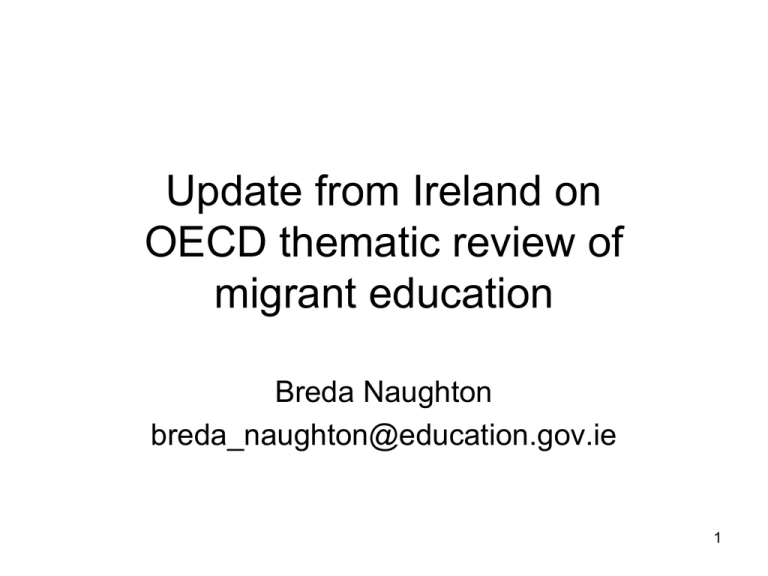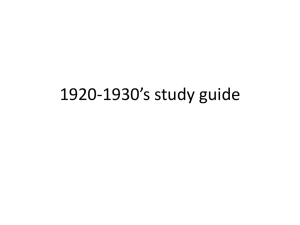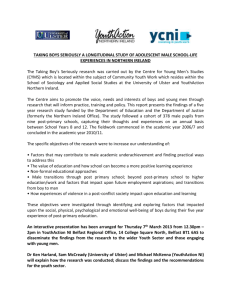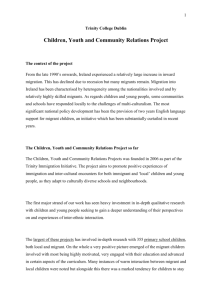Update from Ireland on OECD thematic review of migrant education Breda Naughton
advertisement

Update from Ireland on OECD thematic review of migrant education Breda Naughton breda_naughton@education.gov.ie 1 Key Areas • • • • • • Context Early childhood education and care School – primary and post-primary Partnership and engagement School choice in Ireland Data collection 2 Context in Ireland • • Rapidly changing – migration trends, economy, future? Migrants in Ireland have a different profile to many other countries – – – • • PISA ( 2006) – very small immigrant sample (few second generation) – indicative findings + ESRI (2009) – national survey (www.esri.ie) Students enrolled in urban and disadvantaged schools but also in schools throughout the country – – • Most adults have upper secondary education – may not be in employment commensurate with qualifications Few second generation migrants Approx 10% primary and post primary principals noted that nearly all their students have sustained academic difficulties (ESRI) Less 2% schools have over 50% migrant students in primary Average of 2- 9 % migrant students in post-primary education Approx 70% migrant students do not speak English as their first language on arrival – – Concept of critical period hypothesis theory for EAL students in post-primary – age of arrival is critical Communicative, discrete language skills and academic language proficiency (Cummins, 2009) 3 Early Childhood Education and Care in Ireland • Primary education starts from 4 years • New universal pre-school year for 3 to 4 year olds from Jan 2010 – OECD welcomes initiative • Importance of quality pre/ early school experiences – Need to ensure migrant children participate – Staff have CPD on • diversity • catering for migrant children/ language stimulation – in host and mother tongue • social integration and cohesion – All parents are involved – need for effective communication strategy that includes migrant parents 4 School – Primary and PostPrimary • Teaching is choice of high performers • 160 nationalities and 160+ languages • English as Additional Language Teachers – Few migrant teachers – Budget constraints from 2009/2010 – Majority of EAL students receive two year support – should be based on their identified English language needs • NCCA’s Intercultural Guidelines – advocate a whole school approach • AFL – Assessment toolkits – to guide teachers • “AIM” – Accessing Intercultural Materials Portal • Qualifications for EAL teachers • Research on a north / south basis recommended – area of common interest 5 School – Primary and PostPrimary ( contd) • Pre-service and CPD – inadequate for EAL teachers, mainstream teachers, principals – (role of Teaching Council) • Whole school approach/ positive climate towards diversity • Addressing racism • Language acquisition (host language and preserving and reinforcing mother tongue – important in their linguistic, social and cognitive development) – Greater reliance on in-class support should be promoted to scaffold language learning – importance of interaction with peers 6 Partnership and Engagement • Parents – Information should be easily accessible – May lack knowledge of host country’s education system, of language of instruction and other supports – Cultural differences may hinder their involvement with schools • Encouraging participation in parents councils (at school and national level), in school life – needs proactive personal efforts by school personnel • Immigrant and host communities – Provide mother tongue or English language classes – Liaise with families and service providers – Act as mentors • Home School Community Liaison Scheme – limited service, coordinators need CPD on diversity • Other school / home links 7 School choice in Ireland • Historical context for primary and post-primary schools • Governance challenges in Ireland in 21st Century – concept of patron bodies – live issue • Inspectorate oversees the quality of teaching and learning • 80% schools take all students ( ESRI, 2009) • Schools should evaluate their admissions policies so that they are inclusive and reflect the diversity within their community • Lack of accessible information and community networks may affect informed school choice by parents • Need for enrolment data to be analysed 8 Data collection for evaluation and feedback • AFL – assessment toolkit, tests, state examinations – – – – – – How well do migrant students perform compared to their Irish peers? Adapting teaching practice to reflect needs of diverse student profile Are interventions effective? Involvement of all teachers, not just EAL teachers Support of school leaders CPD in AFL • Lack of data specific to migrants / data protection legislation • Inspectorate’s whole school and EAL evaluations – Promote and support improvement • ESRI – Adapting to Diversity: Irish schools and newcomer students, 2009 (www.esri.ie) • Value for Money Review of EAL expenditure • PISA etc have enlarged newcomer samples into the future • Evaluate policy on evidenced based data 9 The future • Ireland is developing an Intercultural Education Strategy with an implementation plan • OECD country report + Handbook for policy makers – provide significant evidence based data 10



